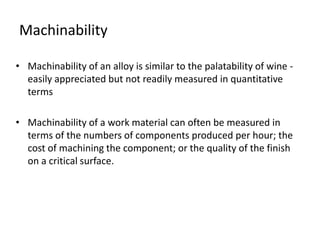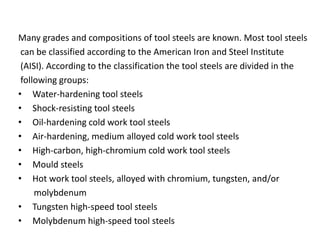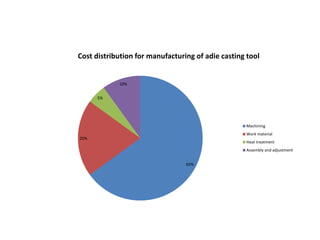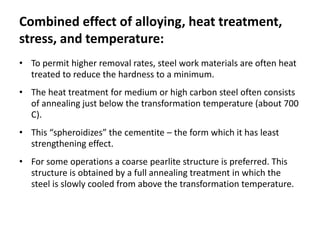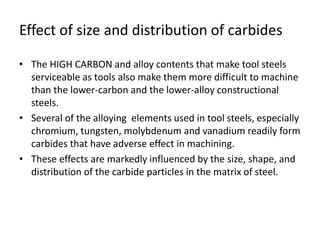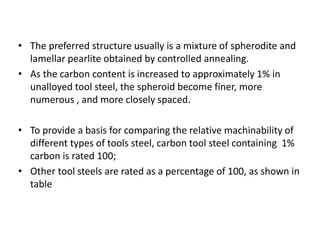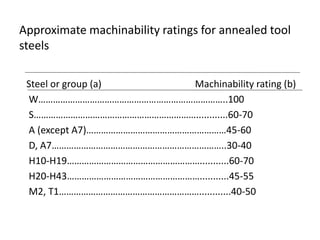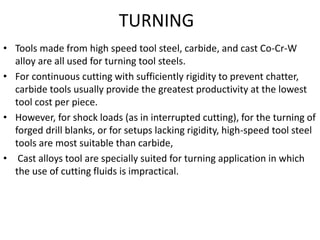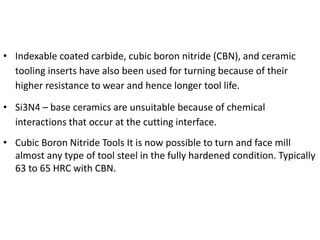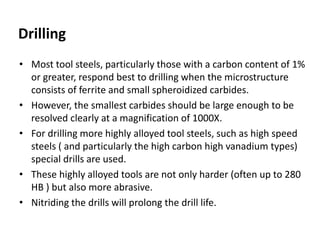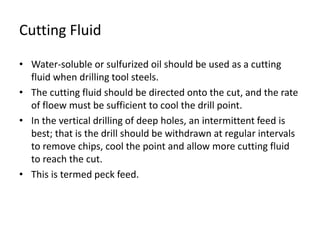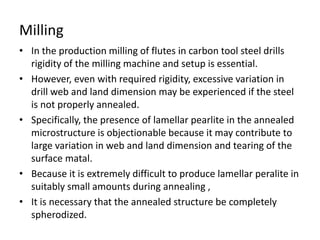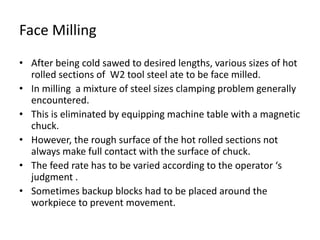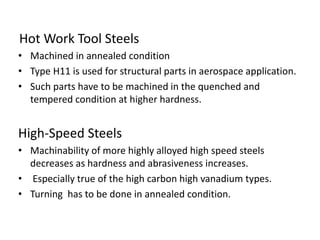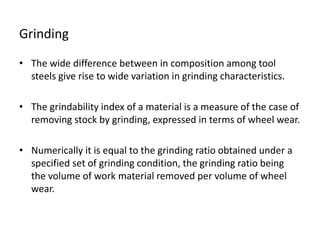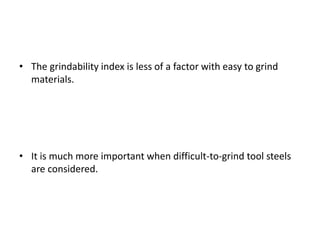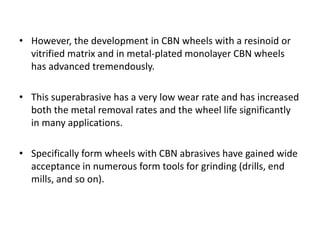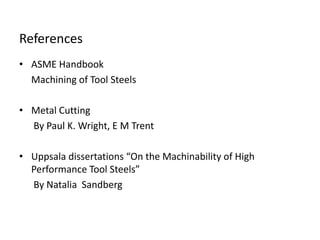Machinability of tool steels
- 1. Machinability of Tool steels -Gaurav Bhati 10BME037
- 2. Machinability ŌĆó Machinability of an alloy is similar to the palatability of wine - easily appreciated but not readily measured in quantitative terms ŌĆó Machinability of a work material can often be measured in terms of the numbers of components produced per hour; the cost of machining the component; or the quality of the finish on a critical surface.
- 3. Many grades and compositions of tool steels are known. Most tool steels can be classified according to the American Iron and Steel Institute (AISI). According to the classification the tool steels are divided in the following groups: ŌĆó Water-hardening tool steels ŌĆó Shock-resisting tool steels ŌĆó Oil-hardening cold work tool steels ŌĆó Air-hardening, medium alloyed cold work tool steels ŌĆó High-carbon, high-chromium cold work tool steels ŌĆó Mould steels ŌĆó Hot work tool steels, alloyed with chromium, tungsten, and/or molybdenum ŌĆó Tungsten high-speed tool steels ŌĆó Molybdenum high-speed tool steels
- 4. ŌĆó Some of the new high performance tool steels are difficult to machine. ŌĆó Machining dominates the cost in tool production as shown in chart. Hence, enhanced machinability would reduce the cost of machining operations through less cutting tool consumption, power consumption and operation time. ŌĆó Machinability of tool steels is influenced by many factors, such as chemical composition, microstructure, inclusions and thermo-mechanical properties.
- 5. Cost distribution for manufacturing of adie casting tool 65% 20% 5% 10% Machining Work material Heat treatment Assembly and adjustment
- 6. Combined effect of alloying, heat treatment, stress, and temperature: ŌĆó To permit higher removal rates, steel work materials are often heat treated to reduce the hardness to a minimum. ŌĆó The heat treatment for medium or high carbon steel often consists of annealing just below the transformation temperature (about 700 C). ŌĆó This ŌĆ£spheroidizesŌĆØ the cementite ŌĆō the form which it has least strengthening effect. ŌĆó For some operations a coarse pearlite structure is preferred. This structure is obtained by a full annealing treatment in which the steel is slowly cooled from above the transformation temperature.
- 7. Effect of size and distribution of carbides ŌĆó The HIGH CARBON and alloy contents that make tool steels serviceable as tools also make them more difficult to machine than the lower-carbon and the lower-alloy constructional steels. ŌĆó Several of the alloying elements used in tool steels, especially chromium, tungsten, molybdenum and vanadium readily form carbides that have adverse effect in machining. ŌĆó These effects are markedly influenced by the size, shape, and distribution of the carbide particles in the matrix of steel.
- 8. Effect of properties of ferrite matrix ŌĆó Most tools steels are easiest to machine when they have been annealed to a microstructure that consist of small spheroidal carbides uniformly distributed in a matrix of ferrite. ŌĆó In tool steels containing less than about 0.75% C, the spheroids are more likely to become large and widely dispersed in relatively large areas of ferrite. ŌĆó Carbides dispersed in this manner cause poor finish and low tool life. ŌĆó If the alloy content of the steel is low, the ferrite is characteristically gummy; ŌĆó and if the alloy content is high, the ferrite is tough.
- 9. ŌĆó The preferred structure usually is a mixture of spherodite and lamellar pearlite obtained by controlled annealing. ŌĆó As the carbon content is increased to approximately 1% in unalloyed tool steel, the spheroid become finer, more numerous , and more closely spaced. ŌĆó To provide a basis for comparing the relative machinability of different types of tools steel, carbon tool steel containing 1% carbon is rated 100; ŌĆó Other tool steels are rated as a percentage of 100, as shown in table
- 10. Approximate machinability ratings for annealed tool steels Steel or group (a) Machinability rating (b) WŌĆ”ŌĆ”ŌĆ”ŌĆ”ŌĆ”ŌĆ”ŌĆ”ŌĆ”ŌĆ”ŌĆ”ŌĆ”ŌĆ”ŌĆ”ŌĆ”ŌĆ”ŌĆ”ŌĆ”ŌĆ”ŌĆ”ŌĆ”ŌĆ”ŌĆ”ŌĆ”ŌĆ”ŌĆ”..100 SŌĆ”ŌĆ”ŌĆ”ŌĆ”ŌĆ”ŌĆ”ŌĆ”ŌĆ”ŌĆ”ŌĆ”ŌĆ”ŌĆ”ŌĆ”ŌĆ”ŌĆ”ŌĆ”ŌĆ”ŌĆ”ŌĆ”ŌĆ”ŌĆ”ŌĆ”............60-70 A (except A7)ŌĆ”ŌĆ”ŌĆ”ŌĆ”ŌĆ”ŌĆ”ŌĆ”ŌĆ”ŌĆ”ŌĆ”ŌĆ”ŌĆ”ŌĆ”ŌĆ”ŌĆ”ŌĆ”ŌĆ”ŌĆ”ŌĆ”45-60 D, A7ŌĆ”ŌĆ”ŌĆ”ŌĆ”ŌĆ”ŌĆ”ŌĆ”ŌĆ”ŌĆ”ŌĆ”ŌĆ”ŌĆ”ŌĆ”ŌĆ”ŌĆ”ŌĆ”ŌĆ”ŌĆ”ŌĆ”ŌĆ”ŌĆ”ŌĆ”ŌĆ”..30-40 H10-H19ŌĆ”ŌĆ”ŌĆ”ŌĆ”ŌĆ”ŌĆ”ŌĆ”ŌĆ”ŌĆ”ŌĆ”ŌĆ”ŌĆ”ŌĆ”ŌĆ”ŌĆ”ŌĆ”ŌĆ”ŌĆ”...........60-70 H20-H43ŌĆ”ŌĆ”ŌĆ”ŌĆ”ŌĆ”ŌĆ”ŌĆ”ŌĆ”ŌĆ”ŌĆ”ŌĆ”ŌĆ”ŌĆ”ŌĆ”ŌĆ”ŌĆ”ŌĆ”ŌĆ”...........45-55 M2, T1ŌĆ”ŌĆ”ŌĆ”ŌĆ”ŌĆ”ŌĆ”ŌĆ”ŌĆ”ŌĆ”ŌĆ”ŌĆ”ŌĆ”ŌĆ”ŌĆ”ŌĆ”ŌĆ”ŌĆ”ŌĆ”ŌĆ”............40-50
- 11. TURNING ŌĆó Tools made from high speed tool steel, carbide, and cast Co-Cr-W alloy are all used for turning tool steels. ŌĆó For continuous cutting with sufficiently rigidity to prevent chatter, carbide tools usually provide the greatest productivity at the lowest tool cost per piece. ŌĆó However, for shock loads (as in interrupted cutting), for the turning of forged drill blanks, or for setups lacking rigidity, high-speed tool steel tools are most suitable than carbide, ŌĆó Cast alloys tool are specially suited for turning application in which the use of cutting fluids is impractical.
- 12. ŌĆó Indexable coated carbide, cubic boron nitride (CBN), and ceramic tooling inserts have also been used for turning because of their higher resistance to wear and hence longer tool life. ŌĆó Si3N4 ŌĆō base ceramics are unsuitable because of chemical interactions that occur at the cutting interface. ŌĆó Cubic Boron Nitride Tools It is now possible to turn and face mill almost any type of tool steel in the fully hardened condition. Typically 63 to 65 HRC with CBN.
- 13. ŌĆó Tool angles: Many form tools are difficult to grind because of their shape or because they must maintain high accuracy. ŌĆó It is economical to use slower speeds and lighter feeds to prolong the life of such tools. ŌĆó Conversely, when the maximum rate of metal removal is the primary objective, as in rough turning, tool grinding is usually simpler. ŌĆó For these condition it is more economical to remove metal at the maximum rate and grind tools more frequently.
- 14. Drilling ŌĆó Most tool steels, particularly those with a carbon content of 1% or greater, respond best to drilling when the microstructure consists of ferrite and small spheroidized carbides. ŌĆó However, the smallest carbides should be large enough to be resolved clearly at a magnification of 1000X. ŌĆó For drilling more highly alloyed tool steels, such as high speed steels ( and particularly the high carbon high vanadium types) special drills are used. ŌĆó These highly alloyed tools are not only harder (often up to 280 HB ) but also more abrasive. ŌĆó Nitriding the drills will prolong the drill life.
- 15. ŌĆó Drill points with the conventional included angle of 118┬░ and normal lip relief angle (about 12┬░ for a 13 mm or ┬Į inch diam drill) are suitable for drilling tool steels of the W, O and L groups. ŌĆó However, drill points with a 130 included angle and lip relief about 2/3 the normal angle are some suitable for drilling steels of the D and A groups and the high speed steels, particularly when hardness of the work material is 260 HB or higher. ŌĆó A 135┬░ crankshaft point is used on high speed tool steel of high hardness, such as M42 and T15.
- 16. Cutting Fluid ŌĆó Water-soluble or sulfurized oil should be used as a cutting fluid when drilling tool steels. ŌĆó The cutting fluid should be directed onto the cut, and the rate of floew must be sufficient to cool the drill point. ŌĆó In the vertical drilling of deep holes, an intermittent feed is best; that is the drill should be withdrawn at regular intervals to remove chips, cool the point and allow more cutting fluid to reach the cut. ŌĆó This is termed peck feed.
- 17. ŌĆó In horizontal drilling, the cutting fluid is directed along flutes of the drill to the point. ŌĆó Intermittent withdrawal of the drill flushes away chips and allows the drill to cool. ŌĆó For deep hole drilling, regardless of workpiece composition, oil-hole drills should be used to permit a continuous supply of cutting fluid at the critical area.
- 18. Milling ŌĆó In the production milling of flutes in carbon tool steel drills rigidity of the milling machine and setup is essential. ŌĆó However, even with required rigidity, excessive variation in drill web and land dimension may be experienced if the steel is not properly annealed. ŌĆó Specifically, the presence of lamellar pearlite in the annealed microstructure is objectionable because it may contribute to large variation in web and land dimension and tearing of the surface matal. ŌĆó Because it is extremely difficult to produce lamellar peralite in suitably small amounts during annealing , ŌĆó It is necessary that the annealed structure be completely spherodized.
- 19. Face Milling ŌĆó After being cold sawed to desired lengths, various sizes of hot rolled sections of W2 tool steel ate to be face milled. ŌĆó In milling a mixture of steel sizes clamping problem generally encountered. ŌĆó This is eliminated by equipping machine table with a magnetic chuck. ŌĆó However, the rough surface of the hot rolled sections not always make full contact with the surface of chuck. ŌĆó The feed rate has to be varied according to the operator ŌĆśs judgment . ŌĆó Sometimes backup blocks had to be placed around the workpiece to prevent movement.
- 20. Hot Work Tool Steels ŌĆó Machined in annealed condition ŌĆó Type H11 is used for structural parts in aerospace application. ŌĆó Such parts have to be machined in the quenched and tempered condition at higher hardness. High-Speed Steels ŌĆó Machinability of more highly alloyed high speed steels decreases as hardness and abrasiveness increases. ŌĆó Especially true of the high carbon high vanadium types. ŌĆó Turning has to be done in annealed condition.
- 21. Tool steel Gears ŌĆó Gear that function in a hot or abrasive environment are sometimes made of a hot-work tool steel such as H11, H12, or H13. ŌĆó Milling is the gear production process most used. ŌĆó One of three procedures is followed, the choice of procedure depending largely on whether the primary requirement is abrasion resistance or heat resistance in service.
- 22. ŌĆó One procedure is to mill the gear teeth in the fully annealed condition (200 to 250 HB) ŌĆó Followed by quenching and tempering to approximately 50 HRC. ŌĆó If this procedure causes excessive distortion, a final grinding operation can be included. ŌĆó When the gear must resist abrasion, common practice is to quench and temper the blanks to 325 to 375 HB, mill the teeth, and then nitride the machined gear. ŌĆó In some instances it is desirable to mill the teeth at higher hardness and employ no further finishing operations.
- 23. Grinding ŌĆó The wide difference between in composition among tool steels give rise to wide variation in grinding characteristics. ŌĆó The grindability index of a material is a measure of the case of removing stock by grinding, expressed in terms of wheel wear. ŌĆó Numerically it is equal to the grinding ratio obtained under a specified set of grinding condition, the grinding ratio being the volume of work material removed per volume of wheel wear.
- 24. ŌĆó The grindability index is less of a factor with easy to grind materials. ŌĆó It is much more important when difficult-to-grind tool steels are considered.
- 25. ŌĆó However, the development in CBN wheels with a resinoid or vitrified matrix and in metal-plated monolayer CBN wheels has advanced tremendously. ŌĆó This superabrasive has a very low wear rate and has increased both the metal removal rates and the wheel life significantly in many applications. ŌĆó Specifically form wheels with CBN abrasives have gained wide acceptance in numerous form tools for grinding (drills, end mills, and so on).
- 26. References ŌĆó ASME Handbook Machining of Tool Steels ŌĆó Metal Cutting By Paul K. Wright, E M Trent ŌĆó Uppsala dissertations ŌĆ£On the Machinability of High Performance Tool SteelsŌĆØ By Natalia Sandberg
Editor's Notes
- #9: Thus the prop of ferrite matrix as well as the size and distribution of carbides can be a major factor in the machinability of tool steel


